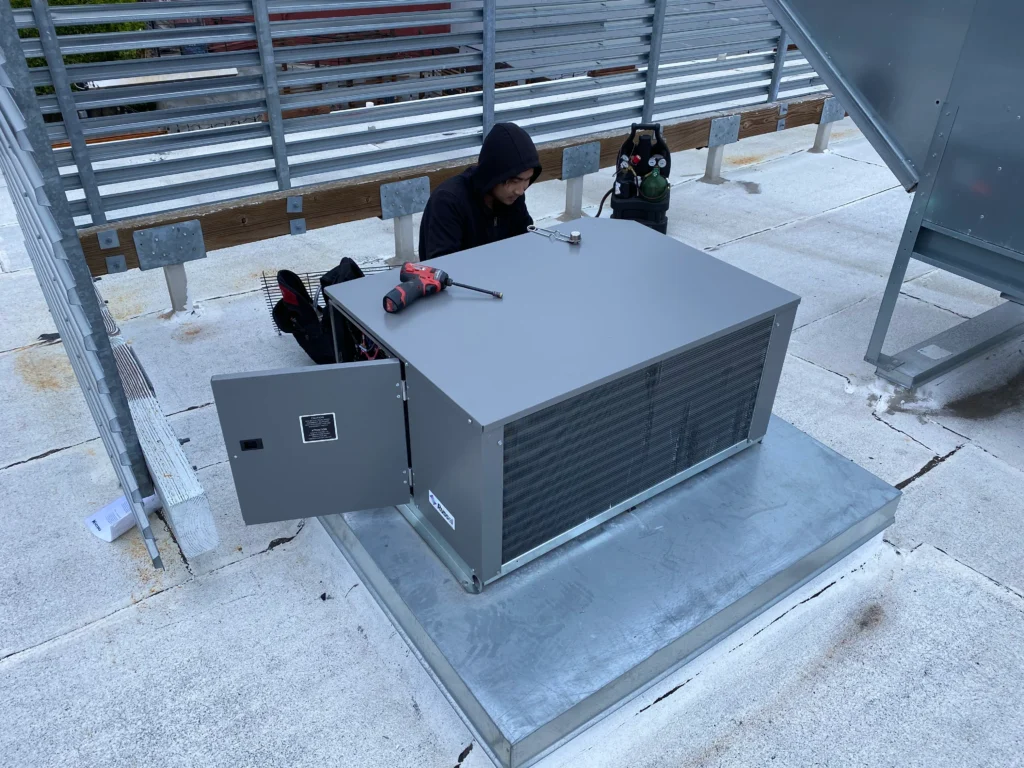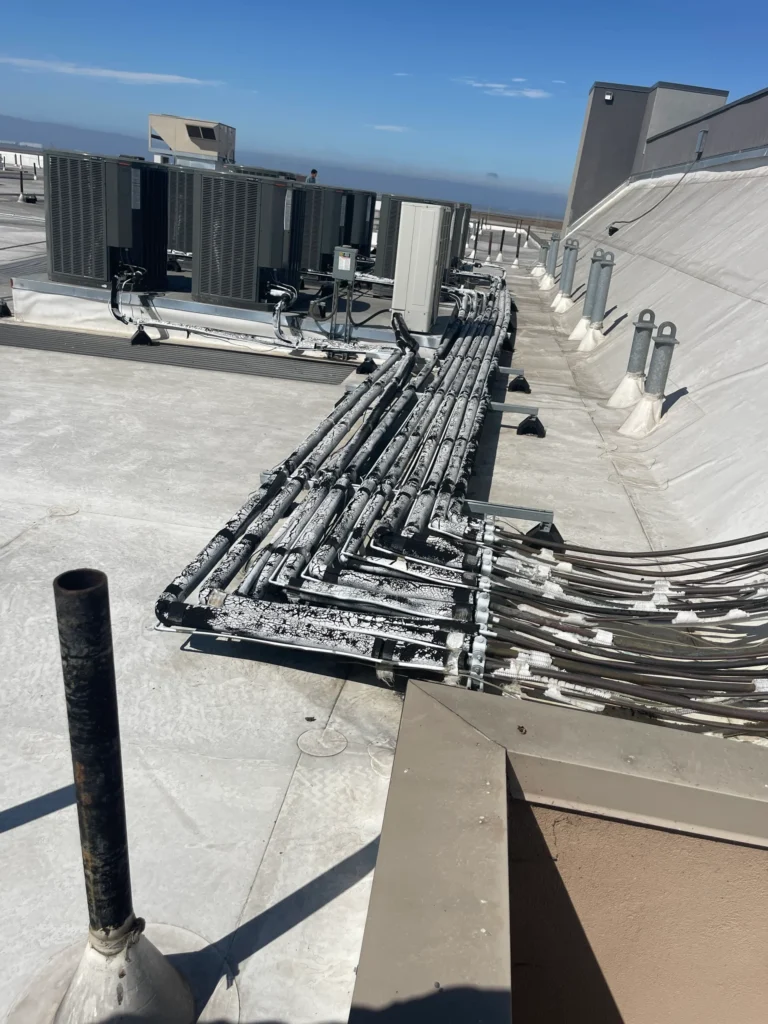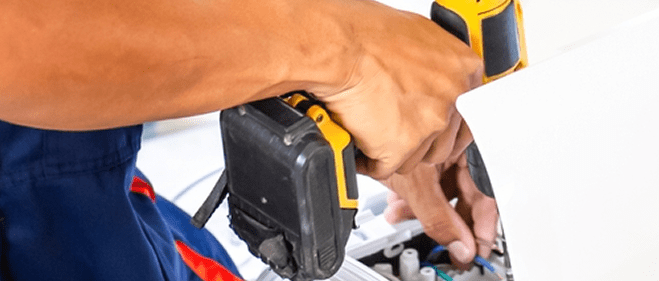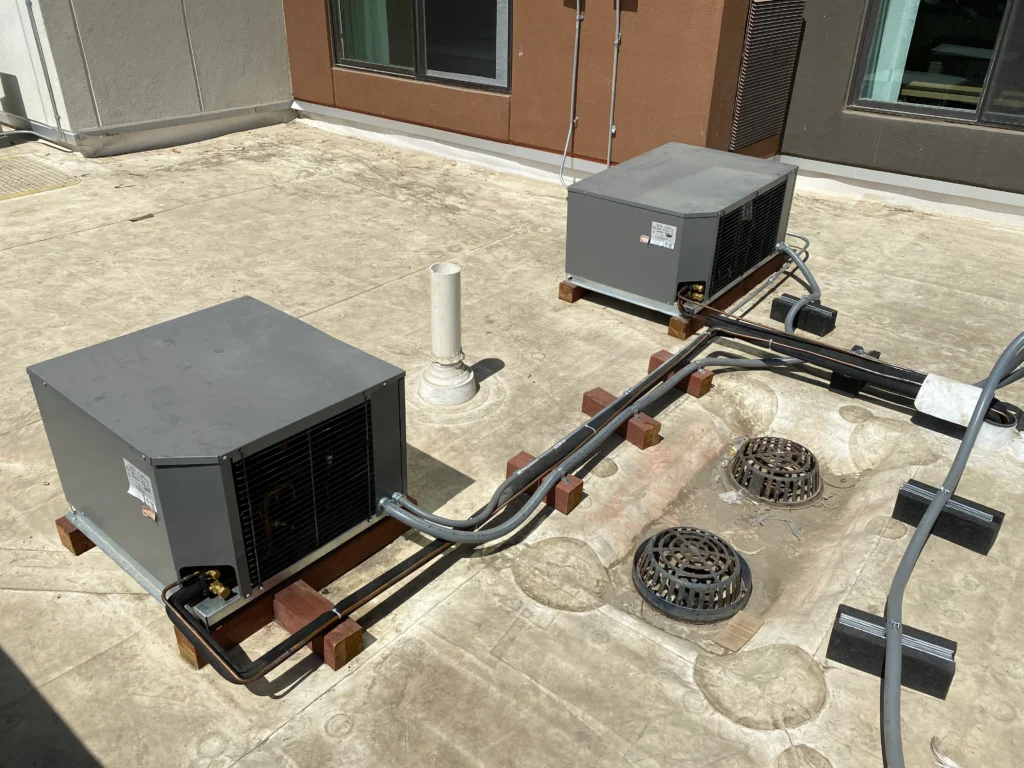Specialized Rooftop HVAC Unit Services
Table of Contents
Specialized Rooftop HVAC Unit Services
Commercial rooftop HVAC units represent one of the most efficient and practical solutions for heating and cooling large buildings. These specialized systems maximize indoor space while delivering powerful climate control from an elevated position that optimizes airflow and energy efficiency.
Yet rooftop HVAC systems require specialized knowledge, equipment, and safety protocols that standard HVAC technicians often lack. Working at height presents unique challenges, while rooftop units face harsh weather conditions that accelerate wear and require expert maintenance approaches.
This comprehensive guide explores the advantages of rooftop HVAC systems, the specialized services they require, and why choosing certified rooftop specialists ensures optimal performance and safety for your commercial building.

Installation & Replacement of Commercial Rooftop Units
Rooftop HVAC installations demand specialized expertise that goes far beyond ground-level system work. The elevated location, structural requirements, and unique installation challenges require contractors with specific rooftop experience and safety certifications.
Professional rooftop installations ensure proper equipment placement, structural integrity, and optimal performance while maintaining the highest safety standards. The complexity of rooftop work makes contractor selection critical for project success and long-term system reliability.
Efficient Use of Space & Simplified Ducting Options
Space optimization represents the primary advantage of rooftop HVAC systems for commercial buildings. By moving equipment to the roof, businesses reclaim valuable indoor square footage that ground-level systems would otherwise occupy. This space recovery often pays for installation costs through increased revenue potential.
Retail businesses benefit significantly from rooftop systems because every square foot of floor space generates revenue. A rooftop unit that frees up 200 square feet of storage or sales space can increase annual revenue by thousands of dollars. Warehouses and manufacturing facilities gain operational space for equipment, inventory, or production lines.
Office buildings use reclaimed equipment space for additional workstations, meeting rooms, or common areas that improve employee satisfaction and productivity. The aesthetic benefits of hidden equipment also enhance building appearance and property values.
Simplified ductwork design reduces installation complexity and ongoing maintenance requirements compared to centralized systems. Rooftop units connect directly to distribution systems through roof penetrations, eliminating long horizontal runs that consume ceiling space and create pressure losses.
Shorter duct runs improve system efficiency by reducing air leakage and pressure drops that force equipment to work harder. Studies show that rooftop systems achieve 5-15% better energy efficiency compared to ground-level systems with extensive ductwork.
Zone control becomes easier with multiple rooftop units serving different building areas. This approach allows precise temperature control for varying occupancy patterns, sun exposure, and usage requirements. Individual zone failures don’t affect the entire building, improving overall system reliability.
Installation scheduling benefits from rooftop locations because work doesn’t disrupt daily business operations. Contractors can complete installations without interfering with customer access, employee workflows, or building operations. This operational continuity reduces business losses during system upgrades.
Rooftop HVAC Maintenance & Repair Solutions
Rooftop HVAC systems face unique environmental challenges that require specialized maintenance approaches. Constant exposure to weather, UV radiation, and temperature extremes accelerates component wear and creates maintenance needs that indoor systems don’t experience.
Professional rooftop maintenance addresses these environmental stresses while ensuring safe access and work procedures. Regular maintenance prevents weather-related damage and extends equipment life despite harsh operating conditions.
Inspections, Cleaning, Component Tune-Ups
Comprehensive rooftop inspections identify problems before they cause system failures or safety hazards. Professional technicians examine not only HVAC components but also structural supports, roof penetrations, and weatherproofing that protect both equipment and building integrity.
Weather damage assessment reveals problems that indoor systems never face. Hail damage to condenser coils, wind damage to fan assemblies, and ice formation that affects operation require specialized diagnostic skills. Early detection prevents minor weather damage from becoming major equipment failures.
Electrical system inspections focus on connections and components exposed to moisture and temperature fluctuations. Rooftop electrical systems face corrosion risks that indoor equipment avoids. Regular inspection and maintenance prevent electrical failures that could cause equipment damage or safety hazards.
Specialized cleaning procedures address contamination levels that exceed those of ground-level systems. Rooftop units accumulate dirt, debris, and airborne pollutants more rapidly due to their elevated exposure. Professional cleaning restores efficiency while preventing premature component failure.
Coil cleaning requires special attention because rooftop units can’t be easily removed for thorough cleaning. Professional technicians use specialized equipment and techniques to clean coils in place while protecting surrounding equipment and building surfaces.
Drain system maintenance prevents water damage from blocked condensate drains. Rooftop drainage problems can cause equipment flooding or building leaks that create expensive damage. Regular drain cleaning and inspection prevent these costly problems.
Component tune-ups address the accelerated wear patterns that rooftop equipment experiences. Moving parts require more frequent lubrication due to temperature extremes and contamination exposure. Belts, bearings, and motors need more attention than indoor equipment.
Refrigerant system maintenance includes leak detection focused on vibration and weather-induced stress points. Rooftop units experience more vibration and thermal cycling that can cause refrigerant leaks. Professional technicians understand these failure patterns and address them proactively.
Control system calibration accounts for temperature sensor exposure and electronic component stress that rooftop installations create. Sensors may require recalibration more frequently due to direct sun exposure and temperature cycling that affects accuracy.

Why Opt for Rooftop HVAC Systems?
Rooftop HVAC systems offer compelling advantages for many commercial applications, but they’re not universally appropriate. Understanding when rooftop systems provide the best value helps building owners make informed decisions about HVAC system selection.
The decision between rooftop and ground-level systems involves factors beyond initial cost. Operating efficiency, maintenance accessibility, and long-term reliability all influence total cost of ownership and system performance.
Reduced Indoor Disruption & Enhanced Energy Performance
Minimized indoor disruption during installation, maintenance, and repairs provides significant operational advantages. Rooftop work doesn’t interfere with business activities, customer access, or employee productivity. This operational continuity translates directly into reduced business losses during system work.
Retail businesses avoid customer disruption during busy shopping periods. Restaurants continue normal operations without noise, dust, or access restrictions that ground-level work creates. Office buildings maintain productive work environments without construction interference.
Emergency repairs benefit from rooftop access because technicians can work immediately without building access coordination or workspace preparation. This immediate access reduces downtime and restoration time when system failures occur.
Enhanced energy performance results from optimal equipment placement and improved air circulation patterns. Rooftop units benefit from better air circulation and heat dissipation compared to ground-level installations surrounded by buildings or landscaping.
Natural convection helps rooftop condenser coils reject heat more efficiently during cooling operations. This improved heat rejection reduces compressor workload and energy consumption. Studies indicate 8-12% energy savings compared to ground-level units with restricted airflow.
Wind patterns at rooftop level improve air movement across heat exchangers, enhancing both heating and cooling efficiency. Ground-level units often experience stagnant air conditions that reduce heat transfer effectiveness.
Temperature differentials between rooftop and ground level create natural ventilation effects that improve system efficiency. Cool night air at rooftop level helps systems operate more efficiently during evening hours when many commercial buildings maintain operations.
Reduced ductwork length and complexity improve overall system efficiency by minimizing pressure losses and air leakage. Shorter duct runs require less fan energy while delivering more effective air distribution throughout the building.

Emergency HVAC Issues We Fix
Your system may need urgent attention if you’re experiencing:
- No airflow from vents
- Furnace blowing cold air
- AC blowing warm air
- System won’t turn on
- Iced-over AC or refrigerant line
- Thermostat not responding
- Loud, unusual noises from the unit
- Weak airflow or poor indoor air quality
- Water leaks around the unit
- Burning smells or electrical odor
- Complete system failure
If you notice any of these signs, don’t wait. Contact COOL AID for immediate HVAC help.
Certified Experts Serving the Bay Area Roofline
Rooftop HVAC work demands specialized skills, equipment, and safety protocols that standard HVAC technicians may lack. The combination of technical expertise and height safety requirements makes contractor selection critical for successful rooftop projects.
Professional rooftop HVAC services combine mechanical expertise with safety certifications that ensure both quality work and accident prevention. This specialized skill set distinguishes qualified rooftop contractors from general HVAC technicians.
Safe, Licensed, & Fully Insured Rooftop Workmanship
Safety certifications demonstrate commitment to accident prevention and OSHA compliance for rooftop work. Professional rooftop technicians maintain fall protection training, height safety certifications, and specialized equipment required for safe rooftop operations.
Fall protection systems, safety harnesses, and proper ladder techniques are non-negotiable requirements for rooftop work. Professional contractors invest in safety equipment and training that protects both technicians and property owners from liability.
Weather awareness protocols ensure safe working conditions and prevent accidents during adverse conditions. Professional rooftop contractors understand when conditions make rooftop work unsafe and postpone operations rather than risk accidents.
Professional licensing ensures technicians understand both HVAC systems and rooftop installation requirements. Commercial HVAC licenses demonstrate competency with complex systems, while roofing contractor licenses may be required for roof penetrations and structural work.
Building permit expertise ensures installations comply with local building codes and safety requirements. Rooftop installations often require permits and inspections that general contractors may not understand. Professional rooftop specialists navigate these requirements efficiently.
Code compliance knowledge covers both HVAC regulations and rooftop safety requirements. Professional contractors understand setback requirements, structural load limits, and safety access requirements that affect rooftop installations.
Comprehensive insurance coverage protects property owners from liability during rooftop work. General liability, workers’ compensation, and specialized rooftop coverage ensure complete protection during installation and maintenance projects.
Equipment insurance covers potential damage to rooftop systems during maintenance or repair operations. Professional contractors carry coverage that protects expensive HVAC equipment from accidental damage during service work.
Bonding provides additional financial protection for large rooftop projects. Bonded contractors demonstrate financial stability and commitment to project completion that protects clients from contractor defaults.
Quality workmanship standards ensure rooftop installations deliver expected performance and longevity. Professional rooftop specialists understand the unique requirements that elevated installations face and build systems accordingly.
Weather sealing expertise prevents water infiltration through roof penetrations and equipment mounting points. Proper sealing techniques protect both equipment and building integrity from water damage that can cost thousands in repairs.
Structural assessment capabilities ensure rooftop installations don’t exceed structural capacity or create safety hazards. Professional contractors evaluate roof strength and modify installations as needed to prevent structural problems.

Maximize Your Commercial Building’s Potential
Rooftop HVAC systems offer compelling advantages for businesses seeking efficient climate control without sacrificing valuable indoor space. These specialized systems require expert installation, maintenance, and repair services that ensure optimal performance and longevity.
Don’t trust your rooftop HVAC investment to general contractors who lack specialized rooftop experience. The unique challenges of elevated installations demand professionals with specific training, equipment, and safety certifications.
Professional rooftop HVAC services combine technical expertise with safety protocols that protect both your investment and your liability exposure. Experienced technicians deliver quality installations while maintaining the highest safety standards throughout the project.
Ready to explore rooftop HVAC solutions for your Bay Area commercial building? Contact 1800coolaid.com today for expert rooftop HVAC services that maximize efficiency while ensuring safety and reliability. Our certified technicians specialize in rooftop installations, maintenance, and repairs that deliver exceptional performance and value. Don’t settle for general contractors—choose the rooftop specialists your commercial building deserves.
Frequently Asked Questions
Are rooftop HVAC units more energy efficient than ground-level systems?
Yes, rooftop units typically achieve 8-12% better energy efficiency due to improved airflow, better heat dissipation, and shorter duct runs that reduce pressure losses. The elevated position provides better air circulation and heat rejection compared to ground-level installations.
What safety measures do you take for rooftop HVAC work?
Our technicians maintain OSHA fall protection certifications and use professional safety equipment including harnesses, guardrails, and proper ladder systems. We assess weather conditions before each job and postpone work when conditions are unsafe.
How often do rooftop HVAC units need maintenance compared to indoor systems?
Rooftop units typically require maintenance every 3-6 months due to increased exposure to weather and environmental contaminants. This frequency is higher than indoor systems but prevents costly weather-related damage and ensures optimal efficiency despite harsh operating conditions.
Serving the Entire Bay Area
We proudly serve customers in:
